#scottish paganism
Text
How To Get Free Books On Folklore
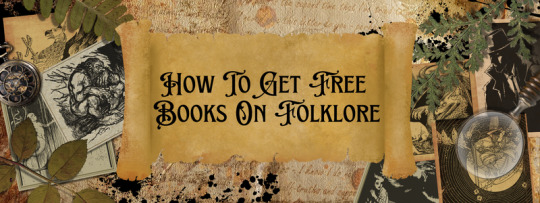
I do not believe in gatekeeping knowledge, so this post will be sharing how I get all my folklore books for free, legally.
To explain, when a book gets over a certain age and the copyright is not upkept, it falls under “public domain.” When that happens, many different websites will provide those books as a free download.
This is not restricted to one type of book, either. You can grab anything from Sherlock Holmes to history books, to folklore, and more.
If you are looking for a specific book, you may have to check more than one source, so I suggest bookmarking more than one website.
Example Websites:
Internet Archive
Project Gutenberg
Google Books
Open Library
Electric Scotland (Scottish books)
Sacred Texts
National Library of Scotland: Ossain Collection
Forgotten Books
Hathitrust
For me when I download a book, I then upload them to my Google library so that I can use the search functions as well as bring up the books anywhere, but a popular PC option isCalibre.
If you are interested in Scotland-specific folklore, I do have some suggestions of books you can start with.
Scottish Folklore Books:
(link) A Dictionary of Fairies: Hobgoblins, Brownies, Bogies, and Other Supernatural Creatures by Katharine Briggs (1976)
(link) Folklore of Scottish Lochs and Springs by James M. Mackinlay (1893)
(link) Superstitions of the Highlands & Islands of Scotland by John Gregorson Campbell (1900)
(link) The Peat-Fire Flame: Folk-Tales and Traditions of the Highlands and Islands by Alasdair Alpin MacGregor (1937)
(link) Notes on Folk-Lore of the North-East of Scotland by Walter Gregor, M.A. (1881)
(link) The Fairy-Faith in Celtic Countries by W.Y. Evans-Wentz (1911)
(link) Witchcraft and Superstitious Record in the South-Western District of Scotland by J. Maxwell Wood (1911)
(link) Witchcraft & Second Sight in the Highlands & Islands of Scotland by John Gregorson Campbell (1902)
(link) Folklore of Scottish Lochs and Springs by James M. Mackinlay (1893)
(link) Folk-Lore From The West of Ross-Shire by C.M. Robertson (1908)
(link) The Fairy Mythology / Illustrative of the Romance and Superstition of Various Countries by Thomas Keightley (1850)
(link) Popular Tales of the West Highlands by John Francis Campbell (1862)
(link) Scottish Fairy and Folk Tales by Sir George Douglas
(link) The Scottish Fairy Book By Elizabeth W. Grierson (1918)
(link)
(link) Popular Superstitions of the Highlands By W Grant Stewart (1823)
#folklore#mythology#myths#lore#scottish folklore#ScottishFolklore#scottish mythology#history#witchcraft#folk magic#folkmagic#paganism#scottish paganism#ResearchResources
3K notes
·
View notes
Text
A Prayer to Rid Oneself of the Evil Eye
Original found (here)
Pagan altered version (here) by Morgan Daimler
In the Carmina Gadelica, a book of gaelic prayers, a prayer against the evil eye is found. It calls upon the strength of the natural world and the Lords three aspects.
Original Gaelic
SALTRAIM air an t-suil,
Mar a shaltrais lach air luin,
Mar a shaltrais eal air burn,
Mar a shaltrais each air uir,
Mar a shaltrais earc air iuc,
Mar a shaltrais feachd nan dul,
Mar a shaltrais feachd nan dul.
Ta neart gaoith agam air,
Ta neart fraoich agam air,
Ta neart teine agam air,
Ta neart torruinn agam air,
Ta neart dealain agam air,
Ta neart gaillinn agam air,
Ta neart gile agam air,
Ta neart greine agam air,
Ta neart nan reul agam air,
Ta neart nan speur agam air,
Ta neart nan neamh
Is nan ce agam air,
Neart nan neamh
Is nan ce agam air.
Trian air na clacha glasa dheth,
Trian air na beanna casa dheth,
Trian air na h-easa brasa dheth,
Trian air na liana maiseach dheth,
’S trian air a mhuir mhoir shalach,
’S i fein asair is fearr gu ghiulan,
A mhuir mhor shalach,
Asair is fearr gu ghiulan.
An ainm Tri nan Dul,
An ainm nan Tri Numh,
An ainm nan uile Run,
Agus nan
Cursa comhla
English translation
TRAMPLE upon the eye,
As tramples the duck upon the lake,
As tramples the swan upon the water,
As tramples the horse upon the plain,
As tramples the cow upon the 'iuc,'
As tramples the host of the elements,
As tramples the host of the elements.
Power of wind I have over it,
Power of wrath I have over it,
Power of fire I have over it,
Power of thunder I have over it,
Power of lightning I have over it,
Power of storms I have over it,
Power of moon I have over it,
Power of sun I have over it,
Power of stars I have over it,
Power of firmament I have over it,
Power of the heavens
And of the worlds I have over it,
Power of the heavens
And of the worlds I have over it.
A portion of it upon the grey stones,
A portion of it upon the steep hills,
A portion of it upon the fast falls,
A portion of it upon the fair meads,
And a portion upon the great salt sea,
She herself is the best instrument to carry it,
The great salt sea,
The best instrument to carry it.
In name of the Three of Life,
In name of the Sacred Three,
In name of all the Secret Ones,
And of the Powers together.
#resources#draoí#evil eye#irish paganism#celtic paganism#gaelic paganism#ireland#magic#draíocht#irish polytheism#celtic Christianity#folklore#folk magic#Scottish paganism#Scotland
34 notes
·
View notes
Text
Having some thoughts on paganism and loss of identity this holiday season.
It felt so easy to study paganism back when I was younger, and while I wouldn't ever call myself a Wiccan these days, I did always appreciate the concept of a year and day of study. I feel like I have to start from scratch after being separated from my community and not feeling inspired for a year or two now really... it gets overwhelming to sort through what's problematic, what's realistic, what's a misrepresentation. At every corner I see Llewellyn books that I know are more likely to contain appropriation than not, and sometimes it feels like that's all there is.
Add in being ND and finding it extremely difficult to focus when there's SO much information out there. I want to find my family's roots, but don't know enough to search for family trees, and am not super excited to sell access to my DNA. I've always been told we were Scottish, but it feels bad to research too deeply into any tradition without knowing our actual connection.
I know what I am, and I'm trying to start by reconnecting to those roots. But also what I am was banned from the family Christmas for years and very traumatized from the treatment as a non-Christian for many years. I find myself deeply missing my community in Texas, who are more family than many I've had even if I have been too traumatized to be able to express that. I don't know what family should or does look like... I don't know what a holiday should look like, either.
I think of family holidays as a teen and I think of my mom telling me I wasn't welcome, being told I was going to burn in hell, who even knows why at that point. Too queer, too mentally ill, too weird, too bad for reputations, too many questions.
I find myself looking forward to things I cant do anymore; community Sabbats at my previous local UU, PNO, Spirit Haven... things just aren't the same here. It's hard to find purchase on unstable ground... churches on every street corner never change, but the pagan community here is different and we just haven't found our place yet. There's a public Norse Altar in the works, but they've been vandalized and stolen from in the process... I'm so wary of anyone calling themselves Wiccan with all the appropriation and casual racism I've witnessed over the years, and it's hard to know who's put in the work to be aware and deconstruct.
I'd love if anyone could make reading suggestions for renewed study. I am open to Celtic, learning about anything Scottish, Norse, and Greek, as well as modern American-influenced traditions and how they've evolved!
#pagan#holidays#yule#winter solstice#christmas#paganism#norse paganism#celtic paganism#greek paganism#scottish paganism#american paganism#tw family#tw holidays
17 notes
·
View notes
Text
i am catholic in the sense that i hate the british, nothing more.
#|| the disciple ||#|| mine ||#scottish paganism#irish paganism#ex catholic#ex christian#religious trauma#religious guilt#anti catholic#catholic guilt#catholic trauma#irish catholic#catholiccore#cathcore#celtic paganism#ex fundie#celtic witchcraft#ex fundamentalist#fuck the church#celtic witch#exvangelical#catholic witchcraft#catholic witch#irish witch#celtic wicca#scottish witch#scottish witchcraft#ex baptist
131 notes
·
View notes
Text
Hey do any Scottish-Irish witches/pagans or those who work with Celtic deities or anything of the sort have any resources or recommendations for what to research? I want to connect with my heritage and expand my craft into it but as a Hellenic Pagan living in Canada I have no idea where to begin 🥲
#any advice or resources or even just words of encouragement are appreciated <3#it’s daunting for me for some reason but I have felt my ancestors calling me for ages#and it’s time to learn and reach out you know?#scottish mythology#irish mythology#irish paganism#Scottish paganism#celtic mythology#celtic pantheon#celtic witch#celtic paganism#hellenic polytheism#hellenic paganism#cj.txt#witchcraft#paganism
69 notes
·
View notes
Text

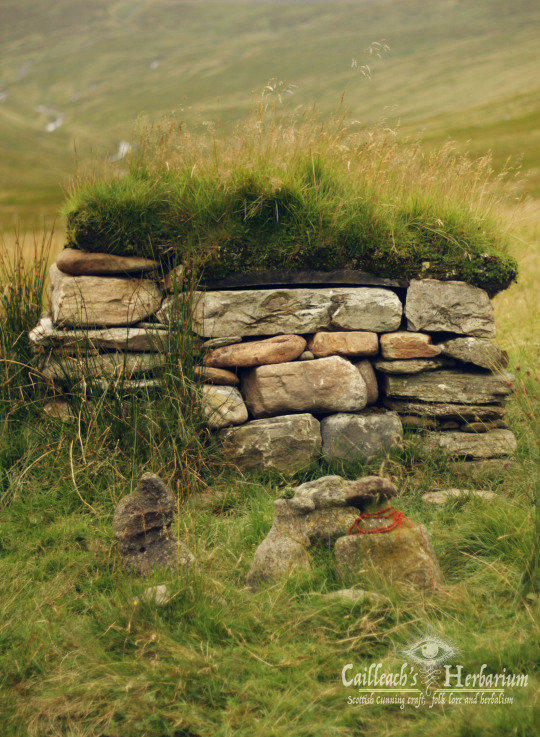
Gleann Cailliche, the valley of the old lady
'The Tigh na bodach houses representations of the Cailleach (old woman) and the Bodach (old man) and their Nighean (daughter) with some smaller statues said to represent other members of this mysterious family. These beautiful arcane looking water worn stones have legends that surround them. Tales I know, tell of a blessing or geas/taboo. Both are perhaps older than those who settled there. The tale recorded, by Dr Anne Ross (1993), follows something like this:
“The fragments … which have survived orally tell of an event which happened ‘many years ago’ when, in an unusually fierce snowstorm, an unnaturally large man and woman were seen coming down the mountain-side of the upper glen. They asked the people who were still settled there for hospitality and shelter. These were willingly given to them. This pleased the supernatural pair well and they took up residence in the glen when the inhabitants had built a thatched house large enough to accommodate them.”
“The woman was pregnant and in due course gave birth to a daughter. The weather was always favourable when they dwelt there. The stock flourished and the crops were always of the best. Then one day the time came when they must go. Before doing so, they promised that as long as they were remembered and their house kept in order, and everything done as they themselves had done it, they would bring it about that winters would be mild, the summers warm, and peace and prosperity would always be with the people who had been so generous to them. In memory of this event of long ago a small shrine in the form of a house was constructed and every Bealtainn the three stones representing the three deities would be taken out of the house and placed facing down the glen. There they remained until the house was re-thatched and made warm and comfortable for the winter and they were returned to the miniature house on the eve of Samhuinn. When the upper glen was flooded and the people moved away”
The two festivals mark the beginning and end of Summer in the old Celtic calendar. The significance to cow farmers is very direct. Bealtainn marked the time when herds were moved out to pasture at the start of summer. They were moved back at Samhuinn, the start of winter. The Cailleach and the Bodach providing blessing through the year to that which people found most precious – their land, cattle, families and clan. (Source)
#the cailleach#scottish polytheism#scottish paganism#scottish mythology#tigh na bodach#Gleann Cailliche
16 notes
·
View notes
Note
🐄🐐
you get: finegas
he’s called fingus in scotland and finegas in ireland, he was a bard and teacher who taught poetry and music as well as science.
use his guidance when you have to step into a teacher role or whenever you’re trying to learn something new!
8 notes
·
View notes
Text
Is anybody out there a practicing Scottish pagan and/or witch? Are there any special Scottish deities that people don't talk about? I know about Scathach, Nicneven, and The Cailleach, but Google just keeps throwing Irish deities at me. And while I'm willing to believe that there is some overlap between the two cultures, I refuse to believe they just share the same gods. Ireland and Wales have different deities, Wales and Brittany had different deities. There's a bunch of water between Ireland and Scotland, I think there'd be a little more differentiation between the two cultures' gods than what direction the accent is pointing in their names.
21 notes
·
View notes
Text

So, I'm trying to expand my library.
I was wondering if anyone had any English language book recommendations for Germanic(not folkish or odinism), Slavic(esp. Polish,) and mainland/Scottish/Welsh, Ancient Egyptian(esp. Set and Nephthys) paganism and folklore?
I don't mind UPG but I prefer works based on archaeology and scholarly sources.
#paganism#slavic paganism#kemetic paganism#scottish folklore#scottish paganism#welsh paganism#book recommendations#youtube recommendations
28 notes
·
View notes
Text
Journey 03/04/2023
My beach was at high tide today, and the shoreline stretched all the way up to the cave entrance (where my door leads to). It was very sunny, and the water was so warm and clear; it was a pleasure being in it. The sand was dark because it was soaked by the sea, and it seemed to melt in my hand.
A daffodil flower head floated up to me, which wasn't unexpected as I had been sitting among them this afternoon. What was more surprising was after I had put the daffodil back, it immediately sunk or 'plopped' back underwater. Then, I saw a golden fish (not sure what kind, either a carp, golden salmon, or just a goldfish) from the side of my eye, swimming about frantically. I tried to catch it and went into the water until I was chest-high. A hand reached out underwater and grabbed my right leg - I was sh****ng myself.
However, I remembered it was just an extension of me, so instead of making rash movements, I grabbed the hand and pulled it out of the water. It looked like a woman; she didn't look mean, nor did she look particularly pleasant. I asked what she was doing there, but I got no reply. I said if she wasn't a diety or spirit trying to get in contact with me or an extension of myself, she shouldn't be here because this is my beach, and I'm trying to make it private. I decided to embrace her and see her off, she smiled, and I smiled back - everything seemed to end quite jovially (which was a relief). Not entirely sure what that was about.
1 note
·
View note
Text

Hope you have a wonderfully spooky night 🎃
📝 Reminder: I have posts on historical Scottish Samhain/Samhuinn folklore
📖 Historic Halloween ( Samhuinn/Samhain): The Basics
👻 Fairies, Turnips, and Ghost; oh my~!
💃 Costumes, Fairs, and Fancy Balls
🐈⬛ Cat-Sìth
🔮 Predicting the Future
🍺 Isle of Lewis Sea God: Shony
#samhuinn#samhain#halloween#scottish folklore#scottish mythology#scottish myths#scottish paganism#witchblr
30 notes
·
View notes
Text
Bride is said to preside over the different seasons of the year and to bestow their functions upon them according to their respective needs. Some call January 'am mios marbh,' the dead month, some December, while some apply the terms, 'na tri miosa marbh,' the three dead months, 'an raithe marbh,' the dead quarter, and 'raithe marbh na bliadhna,' the dead quarter of the year, to the winter months when nature is asleep. Bride with her white wand is said to breathe life into the mouth of the dead Winter and to bring him to open his eyes to the tears and the smiles, the sighs and the laughter of Spring. The venom of the cold is said to tremble for its safety on Bride's Day and to flee for its life on Patrick's Day. There is a saying:--
‘Chuir Bride miar ’s an abhuinn
La na Feill Bride
Is dh’ fhalbh mathair ghuir an fhuachd,
Is nigh i basan anns an abhuinn
La na Feill Padruig
Is dh’ fhalbh mathair ghin an fhuachd.'
Bride put her finger in the river
On the Feast Day of Bride
And away went the hatching mother of the cold,
And she bathed her palms in the river
On the Feast Day of Patrick
And away went the conception mother of the cold,
Another version says:--
'Chuir Brighid a bas ann,
Chuir Moire a cas ann,
Chuir Padruig a chiach fhuar ann.' (?)
Bride put her palm in it,
Mary per her foot in it,
Patrick put the cold stone in it,
alluding to the decrease in cold as the year advances. In illustration of this is-- 'Chuir Moire meoirean anns an uisge La Fheili Bride is thug i neimh as, ’s La Fheill Padruig nigh i lamhan ann ’s dh’ fhalbh am fuachd uil as,' Mary put her fingers in the water on Bride's Feast Day and the venom went out of it, and on Patrick's Feast Day she bathed her hands in it and all the cold went out of it.
Carmina Gadelica, Volume 1, by Alexander Carmicheal, [1900], at sacred-texts.com page 172
1 note
·
View note
Text
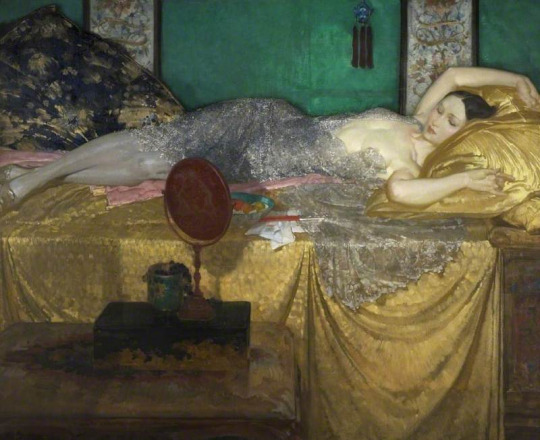
William Russell Flint (Scottish, 1880-1969) • Silver and Gold • 1929/1930 • Birmingham Museums Trust, UK
#art#painting#fine art#art history#women in paintings#portrait#beauty#william russell flint#scottish artist#sultry portrait#pagan sphinx art blog
387 notes
·
View notes
Text
Valyrian Wedding Rituals & Its Parallels
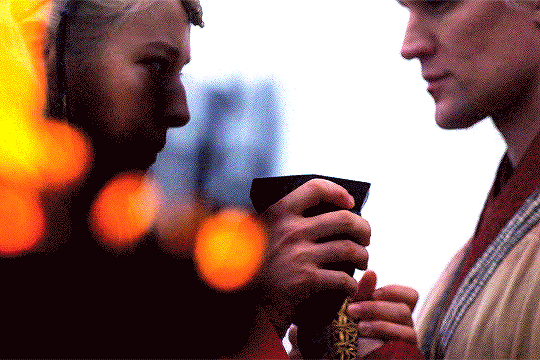
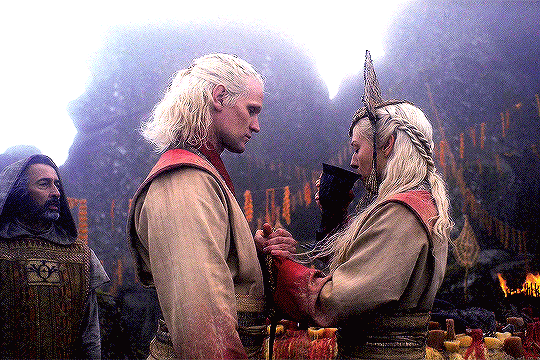




“Among the people who came to inhabit Northumbria and the Lothians, as well as among other Germanic peoples, the nuptials were completed in two distinct phases. (…) The parties plighted their troth and the contract was sealed, like any other contract, by a hand-shake. This joining of hands was called handfæstung in Anglo-Saxon, and the same word is found in different forms in the German, Swedish and Danish languages. In each it means a pledge by the giving of the hand.”
Handfasting' in Scotland - The Scottish Historical Review; Anton, A. E. (1958)
“In ancient Rome, a wedding was a sacred ritual involving many religious practices. (…) In a Roman wedding both sexes had to wear specific clothing. Men had to wear the toga virilis while the bride to wear a wreath, a veil, and a yellow hairnet.”
Women's Costume and Feminine Civic Morality in Augustan Rome; Sebesta, Judith Lynn (1997)
“ When the terms of the ketubah were accepted a cup of wine was shared to seal the marriage covenant. (…) The bride and groom shared the same cup, symbolizing the shared life that would be theirs. (…) Wine in Judaism has always symbolized joy. (…) Wine also symbolized blood. The marriage covenant is a blood covenant in the eyes of God. Two lives become one in a lifelong commitment.”
The Ancient Jewish Wedding; Lash, Jamie (2012)
#daemon targaryen#daemon x rhaenyra#daemyra#hotd#fantasy#game of thrones#rhaenyra targaryen#house of the dragon#house targaryen#asoiaf#wedding vows#old valyria#ancient rome#roman empire#roman history#jewish history#judaism#jewish culture#celtic paganism#scottish
208 notes
·
View notes
Text
Restarting my journey into paganism and would love to follow some people. Please interact with this post or follow me if you post about
Nature (reverence, conservation, etc)
Gaelic and/or Norse polytheism and mythology
Folk magic and witchcraft, herbalism 🍃🌿🍄
Pagan crafts
ABOUT ME
I’m 18+ and in the US.
I abhor racism, TERFs, and cultural appropriation.
I practice Norse and Scottish polytheism, but I am learning about others.
I primarily worship Freyja, Odin, and the Cailleach, among many others.
Also, I’ve got a ton of books that I’m reading or that are on their way to me, so I’ll try to post about them.
#paganism#celtic paganism#sorry for using that term - I know those cultures are not homogeneous#witchblr#scottish paganism#scottish polytheism
17 notes
·
View notes
Note
🌊
you get: meg the healer
a famous scottish healer who was even called upon by the local fairy folk when they fell ill. she lived to be 100 years old and was taken to the fairyland where she might still reside!
she’s there to turn to when you need healing, herbal knowledge, or to help aid in fairy contact
4 notes
·
View notes